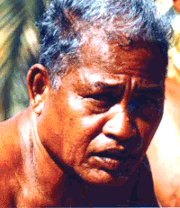Mau Piailug
| Mau Piailug | |
|---|---|
 |
|
| Born |
Pius Piailug 1932 Weiso, Satawal, Yap, Federated States of Micronesia |
| Died | July 12, 2010 (aged 78) Satawal, Yap, Federated States of Micronesia |
| Cause of death | Complications of diabetes |
| Nationality | Micronesian |
| Other names | Mau, Papa Mau |
| Education | Weriyeng school of navigation |
| Occupation | Navigator, canoe builder, teacher (kumu) |
| Years active | 1948–2007 |
| Known for | Wayfinding, Polynesian navigation, Hawaiian Renaissance |
| Spouse(s) | Nemwaeito (alt. sp. Nemoito) |
| Children | 16 |
| Parent(s) | Orranipui (father) |
| Relatives | Urupoa (brother) |
| Awards | Special fellowship, East-West Center (1976) Honorary Doctor of Humane Letters, UH (1987) Robert J. Pfeiffer Medal (2008) |
Pius "Mau" Piailug (pronounced /ˈpaɪəs ˈmaʊ piːˈaɪləɡ/; 1932 – July 12, 2010) was a Micronesian navigator from the Carolinian island of Satawal, best known as a teacher of traditional, non-instrument wayfinding methods for open-ocean voyaging. Mau's Carolinian navigation system, which relies on navigational clues using the sun and stars, winds and clouds, seas and swells, and birds and fish, was acquired through rote learning passed down through teachings in the oral tradition. He earned the title of master navigator (palu) by the age of eighteen, around the time the first American missionaries arrived in Satawal. As he neared middle age, Mau grew concerned that the practice of navigation in Satawal would disappear as his people became acculturated to Western values. In the hope that the navigational tradition would be preserved for future generations, Mau shared his knowledge with the Polynesian Voyaging Society (PVS). With Mau's help, PVS used experimental archaeology to recreate and test lost Hawaiian navigational techniques on the Hōkūle‘a, a modern reconstruction of a double-hulled Hawaiian voyaging canoe.
...
Wikipedia
